Student Lesson: Hill Work
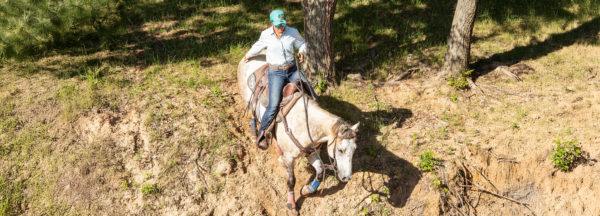
Three and a half weeks into the Academy course, students were working their horses over obstacles and riding outside of the arena. The first few lessons under saddle focused on establishing a good gas pedal and brake outside of the arena by practicing One Rein Stops, Yield to a Stop, loping on a loose rein and Tree-to-Tree. Gradually, exercises were added to work on the horse’s steering and softness.
When the class was ready, I worked with Alicia to demonstrate how to teach a horse to properly negotiate hills. When I ask a horse to go up or down a hill, I want him to creep and think about where he’s placing his feet. That’s the complete opposite of a horse that scrambles down a hill, building speed, or one that bolts up an embankment. A horse that pays no attention to how he goes up or down a hill is one that’ll get you into a bad wreck.
If you want your horse to handle hills well, you have to train him to do so. Left on their own, most horses rush up and down inclines. The creek bed at the ranch is a perfect place to practice training a horse to handle hills well because it offers varying degrees of difficulty.

Alicia puts her horse on a loose rein and encourages him to go down the hill. When you’re taking your horse up and down hills, always keep him on a loose rein. This stops you from babysitting your horse and protecting him from making a mistake. If you want your horse to learn to be responsible for his own actions, you have to allow him to make mistakes and then correct him. Keeping the horse on a loose rein also allows him to use his neck for balance as he’s going up or down a hill. The steeper the grade of the hill you’re riding on, the more important this is. If you need to balance going uphill, lean forward and hold onto the horse’s mane or saddle horn. Do not hold onto the reins for balance or support.
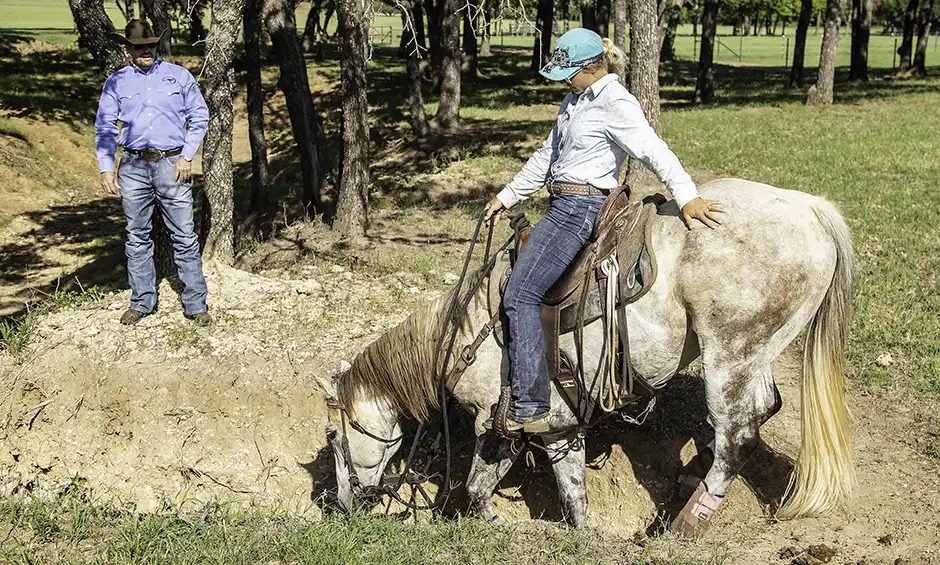
As the horse picks his way down the hill, Alicia rubs his hindquarters and encourages him to take his time. Any time the horse stopped, Alicia rubbed on him and let walking forward again be his idea. I warned her not to make him feel wrong for taking his time. His stopping was the complete opposite of him rushing up or down the hill.
While Alicia’s horse picked his way carefully down the hill, when you first start working on hills with your horse, it’s likely that he’ll speed up going down the hill because he hasn’t figured out yet how to control his body. That’s normal. Let him rush down the hill if he wants to.
Once he reaches the bottom of the hill, instantly put his feet to work. Most horses will have a tendency to veer off in one direction when they reach the bottom. Whichever direction your horse veers off in, turn him in the opposite direction and hustle his feet in bending circles, trot him around nearby bushes or trees.
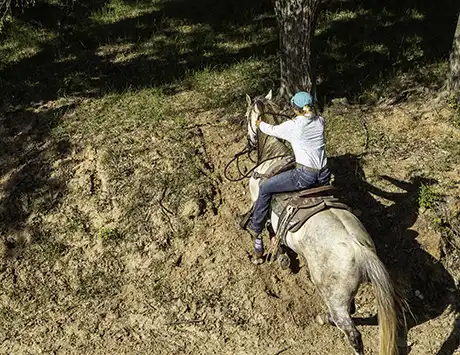
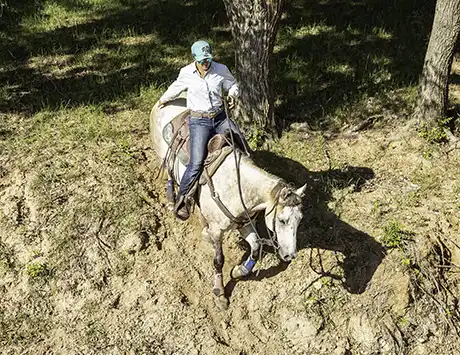
Because her horse stayed in a straight line and didn’t veer left or right, I had Alicia ride straight up the other side of the creek. Again, she kept the horse on a loose rein, not pulling on his mouth or babysitting him
At the top of the creek, Alicia circled her horse around a tree and then headed back down the creek. Circling at the top of the hill serves as a quick reminder to the horse to check in, pay attention to his rider and soften his body. It also deters a horse from rushing up a hill. If every time he gets to the top of the hill, you hustle his feet for a few minutes, he’ll soon stop being in a hurry to scramble up the hill because he’ll realize that nothing but hard work is waiting for him.
A good rule of thumb is to complete four circles around two trees, or whatever objects you can find to circle around. If there are no objects around you, bend your horse in four circles to the right and then four circles to the left.

Alicia ended the lesson with her horse on a good note. He consistently took his time negotiating the hill and was tuned in to her.
With the demonstration over, I turned all of the students loose to train their horses to creep up and down hills using the creek.
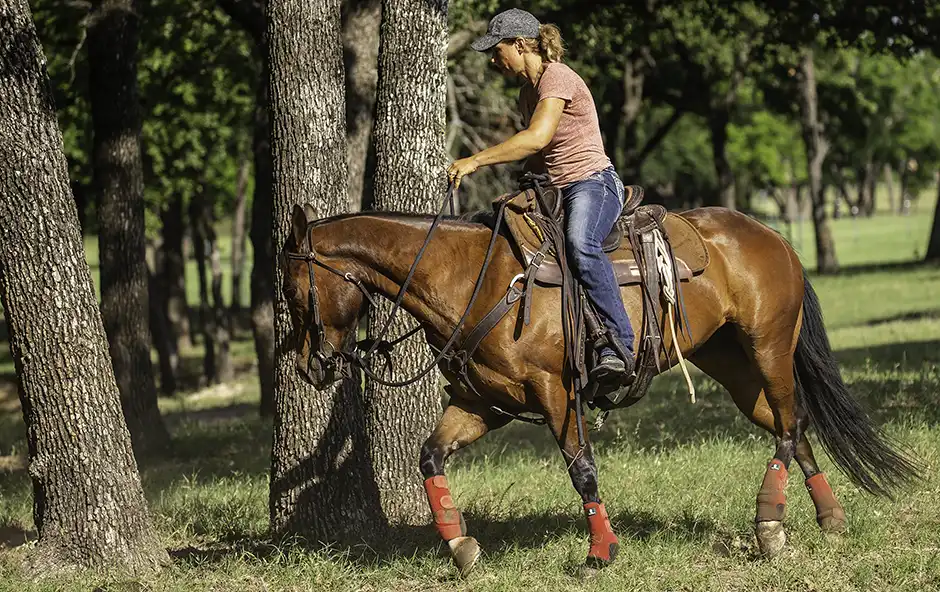
After coming up the creek, Tracy set straight to work trotting her horse in a circle around a tree. With repetition, the horse will not want to get to the bottom or top of the hill in a hurry because he knows he’s going to have to sweat and work hard there. How long it takes for the horse to come to this realization depends on the individual. If a horse is a chronic rusher, you can make an improvement in one training session, but more than likely it’ll take several sessions in a row to erase his old habits. Remember, it didn’t take him just one time to develop that longstanding bad habit.
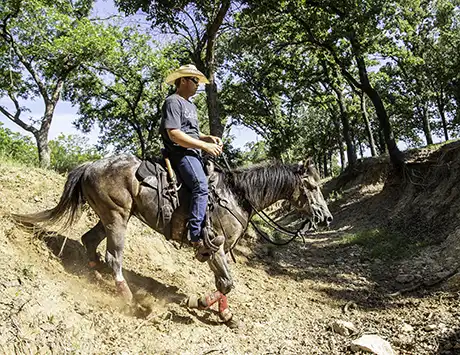
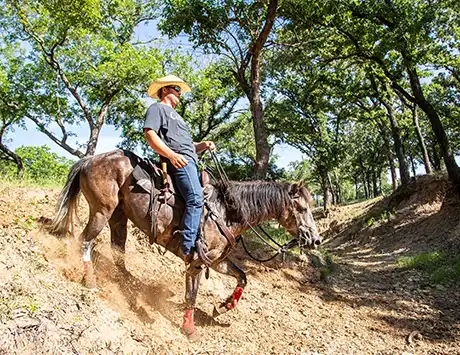
Your position in the saddle affects how well your horse goes up and down hills. A lot of riders have a bad habit of leaning forward over the horse’s neck or leaning too far back when riding hills. Jeffery demonstrates here (left) a good position to be in when going downhill; he’s leaning back slightly to help his horse balance himself.
Compare that to here (right), where he’s leaning back too far in the saddle. A good rule of thumb is to keep your spine parallel to the trunks of trees you pass on the hill.
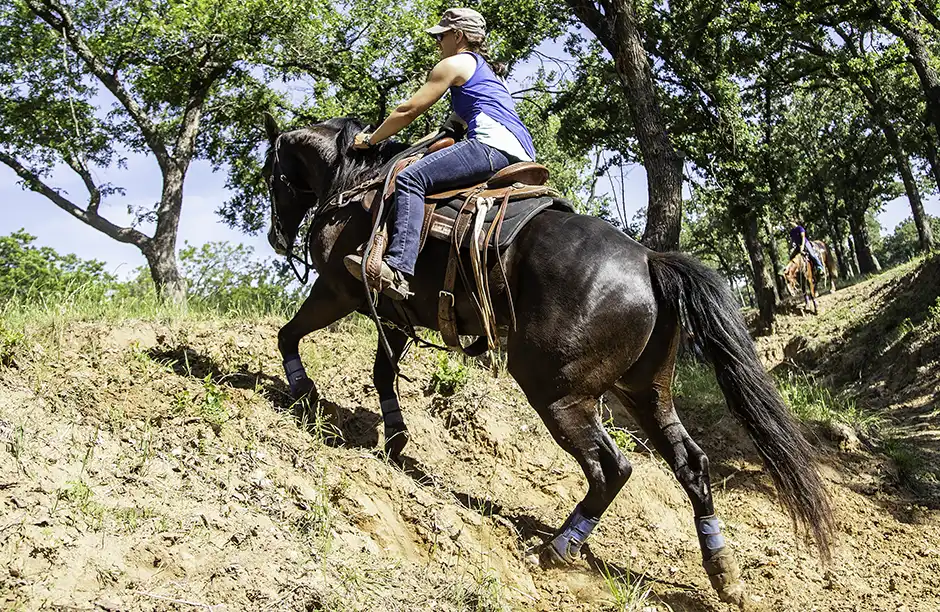
Anna urges her horse up the side of the creek, keeping him on a loose rein. Keep in mind that when a horse is going up a steep embankment, he will have to put in a little extra effort to get up the hill. While your goal is for the horse to creep up and down hills, you have to be realistic about the energy he’ll require to get up the hill. However, that doesn’t mean that the horse gets a free pass to bolt up the hill. Most horses want to trot or gallop because it takes less strength to go faster. Even if you’re working on a steep hill, he can still walk up it; it just might be more of a power walk than a slow amble.
Pay Attention to the Ears
When you’re working on hills, how your horse is holding his ears can be a telltale sign. If they are pricked forward, it’s generally a tipoff that he’s getting ready to speed up and he’s not paying attention to you. I like when my horses have their ears cocked back toward me. That tells me that they are paying attention to what I’m asking them to do and they’re continuously checking back in with me.
